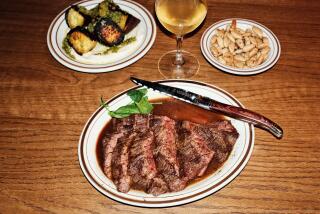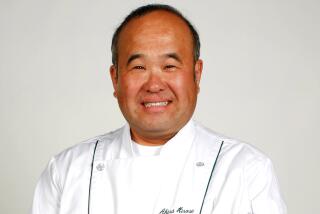Hot Springs Offer a Time-Honored Cure for Whatever Ails You in Japan
- Share via
KAWAHARAYU, Japan — When winter’s on the way you may see a long line of what look to be geese stretching across the gray sky. But they don’t compare with the long lines of Japanese heading for onsen.
Other countries have hot springs and special cold-weather spas that attract tourists during the icy times. But perhaps only Japan has the devotees who make onsen (the Japanese word for hot springs) such great experiences.
Hot springs in Japan have long been recognized for their ability to cure what ails you. Hiroshi Morinaga, a recognized expert in onsen , says the first hot springs flowed when two Japanese gods of medicine needed special stations to effect their cures.
He says hot springs have since been used to relieve stomach, intestinal, liver and gall bladder disorders and a host of lesser ills including gout. But the rather serious side of onsen doesn’t do the practice, indeed the ritual, much justice.
An onsen is a hotel built around a hot spring, which is like saying a Rolls-Royce is several sheets of metal wrapped around an internal combustion engine.
Going Limp
Japanese TV programs and magazines and newspapers abound with pictures of the weary literally going limp in steamy hot water. Usually these folks will have a towel draped over their heads and perhaps they’ll be sipping a bit of sake from a cup on a floating tray by their sides. And it’s all wrapped in a hazy warm wonder.
The water, reeking of sulfur and other minerals, gurgles hot from the volcanic network that rumbles beneath Japan. If one must endure earthquakes and the spout of the occasional volcano to get onsen , everyone seems prepared to do so.
This small town in Gumma Prefecture is about three hours from Tokyo by a ratcheting train that butts its way into the razorback, evergreen-covered mountains. The taxi driver claims Kawanaka Onsen is the only onsen in town. In all of Gumma there are said to be 60 onsen. But then, who’s counting?
Kawanaka is a modest, even rustic scruffy place run by 60-year-old Tamiko Kobayashi. She is the welcome antithesis of the stereotypical Japanese woman. Her dynamism is apparent from the first noisy greeting:
“You got plenty of gray hair. We’ll take care of that,” she shouts at the entrance. If she were an American she’d be from New York City, or at least Brooklyn.
Good-Cheer Laughter
“I’m an amazing woman!” she yells, and lets out a long line of genuine, good-cheer laughter. “Where’d you get all that gray hair? We’ll have to get you relaxed, get the wrinkles out.”
If the wrinkles are going to be got out, this is the place to get it done. Her onsen is reputed to be blessed with waters that will make one’s skin smoother and healthier. The minerals in the water are said to have particularly good effects on women of about 25. But for those men and women of a later generation, Mrs. Kobayashi recommends that you drink your fill of water while bathing.
“If you’ve got digestive problems, this water will clear everything up. It can even help you lose weight--if you need to,” she says diplomatically.
Guests struggle out of shoes and pad along the polished corridor to their traditional Japanese rooms, tatami straw mats, paper and wood sliding doors, thick futon and pillows and . . . pay TV. They sip at green tea, eat sweet rice cakes and relax to the sound of birds echoing through the forest.
“The bath is open any time. Just go down,” Mrs. Kobayashi yells through the door.
The walls of the bath are stone and glass. The huge windows can slide open to let in cool air and the pleasing sight of nothing but trees and mountainsides.
Blissfully Alone
One soaps up, rinses off and enters the steamy water that’s covered by a thin mist. Only a few guests are here midweek. One is left blissfully alone. This kind of experience will make you at least feel healthier if not look it.
Once out of the water, after about an hour of gurgling joy, dry off and climb into the crisp cleanliness of your yukata, a kimono-like robe that’s proper attire at any onsen. The atmosphere is casual simplicity.
As it turns out, the weight-reducing qualities of Kawanaka’s waters are indeed important. Each onsen prides itself on its special meals. Some places are known for elaborately decorated sashimi dishes, others feature delicate gatherings of tofu in beautiful array.
Mrs. Kobayashi’s specialties are based on simple mountain fare. She makes just about everything herself. The sashimi comes from carp she tends in a small pond in back of the kitchen. The water is tangy cold, which makes the fish especially fresh-tasting.
She makes her own pickles, as do most homemakers in Japan, using her own recipe. Part of the taste likely comes from the big wooden tubs where the vegetables cure. There’s sea salt and hot chili peppers, but recipes are forgotten on the first bite.
Just about anything Mrs. Kobayashi puts on the table tastes great, but her specialty is udon. These are thick noodles that are extremely popular in Japan. You can get a bowl of udon at most any train station. The noodles will be swimming in a weak broth with a few chopped vegetables sprinkled on top. They are one of Japan’s original fast-foods.
Fresh Nuttiness
But you can only get Mrs. Kobayashi’s udon at her onsen. These noodles are as thick as a man’s little finger but burst with the fresh nuttiness of yesterday’s ground grain. They are set into a thick broth of miso (a much better name for what is, in English, bean paste) and chunks of crispy fresh vegetables grown by farmers just up the road. This is a dish of rare occurrence in a world of prepackaged bland.
Need a walk afterward? Stroll along the back roads of Gumma. One recent afternoon several walkers were startled by a rumbling in the forest above the road. A huge black shape appeared among the leaves. They were convinced it was a bear, one of the common inhabitants of the region.
“It’s just a mountain goat,” said a farmer. “They’re all over the place. Hunters shoot them all the time.”
The goat, with full coat of winter fur, edged down to a gurgling stream for a peaceful afternoon drink. No one would be shooting him today.
Along the busier main highway is the famous Wagamakekoku Gorge. Japanese say it’s a favorite setting, in various disguises and other names, for mysteries where lovers end unhappy trysts with the death of one or the other or both. The steep rocky sides of the gorge and the thundering rapids of emerald green water give the place a lonely feeling. Mystery writers understand this.
But they leave out Mrs. Takahashi who runs the little store near the entrance to the gorge.
Guests, even those just buying a cold drink, are made to sit down for some hot green tea and her own brand of pickles, which would probably go just as well with cold beer or hot sake. She is dressed in a well-worn kimono and puffs a cigarette.
A Jumble of Wares
Her store is a jumble of old furniture, pots bubbling on a stove, faded souvenirs and dusty boxes. From one, set on top of a rickety shelf, she pulls out a sheaf of pictures.
“This is my son,” she says, pointing to the photo of a proud pilot. “He flies for Japan Air Lines now. He goes all over.” She has saved each photograph, each post card, each letter from the man’s career. She pours a little more tea, serves a few more pickles.
At times, the openness of country folk is a little disconcerting, especially after the reticence of city dwellers. But after another soak in the steamy pool at Mrs. Kobayashi’s onsen , the night’s meal wafting its luscious aroma through the huge open windows, it all begins to seem right. And you swear you’ve got less gray hair than when you arrived.
-- -- --
Kawanaka Onsen is a 2 1/2-hour ride by express train from Tokyo’s Ueno Station ($20 one way). A considerably cheaper but slower train service is also available from Ueno Station. From Kawaharayu Station, Kawanaka Onsen is a 10-minute bus ride and a 20-minute walk up the only road leading from the highway. Taxi service is often available and costs about $3. The woman at the small restaurant next to the station knows the driver and the onsen and is willing to make some phone calls if you appear stranded.
For reservations, contact Mrs. Kobayashi at Kawanaka Onsen, Wagatsuma-cho, Wagatsuma-gun, Gunma Prefecture, Japan. $35-$50 a night including two meals.
Wagamakekoku Gorge begins 100 meters from the train station. Mrs. Takahashi’s eatery is just above the bridge. A hefty lunch for two including homemade udon noodles, vegetables, pickles, hot tea and a surprise or two will run about $5 for two.
More to Read
Sign up for The Wild
We’ll help you find the best places to hike, bike and run, as well as the perfect silent spots for meditation and yoga.
You may occasionally receive promotional content from the Los Angeles Times.






